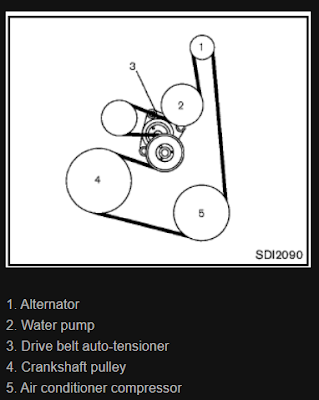If you start the car and it looks like the BRAKE and BATTERY symbols light up at the same time on your Nissan Rogue - theres some stuff to watch out for before you hit the highway and why you should take a minute and pop your hood.
STARTING SYMPTOM:
- BRAKE and BATTERY light come on at the same time
This indicates that your battery is discharging faster than its charging - which also tells us that the alternator is not working well and feeding charge back into the battery. The problem gets worse for your battery the more electrical components you turn on - lights, AC, radio, etc.
Sometimes however this can indicate a more serious issue, which is what I'll cover in todays post since it happened to me.
Note: these symptoms are not always accompanied by a CHECK ENGINE light!
WHAT TO WATCH OUT FOR:
First thing I noticed was driving a couple of minutes my engine temperature started to rise.
I have never seen that happen before so I chalked it up to some sensor malfunction because it seemed absurd that a battery charge issue would overheat the engine. However as soon as the temperature went to maxtemp - ie where it says "HIGH" on the engine temperature guage, the car took self-protective measure and started stalling/ interrupting the engine. You can also LOOSE POWER STEERING! Fortunately I was on a local road coasting at 20 MPH so it did not jeopardize us however I can imagine at highway speeds this can create some significant safety scenarios.
IF YOUR ENGINE TEMP IS HIGH AND THE CAR STARTS TO STUTTER OR STALL ..
Please pull over. You must shut down as soon as possible to avoid overheating as well as potentially losing power steering etc.
AFTER ENSURING ENGINE IS NOT OVERHEATING / YOU'RE SAFELY SHUT DOWN..
Pop open the hood and take a look at your coolant fluid. if you see its way over the level where it normally is, it indicates something about the alternator fan belt (aka "serpentine belt") or something in the same area is interfering with the transfer of rotational power from the engine to remaining parts that do things like:
* power steering
* coolant circulation
* air conditioning
* recharging battery via alternator
* etc
Once the engine is off, if you see that the coolant level is falling back down to normal levels, then take a look at the
SERPENTINE BELT (aka ALTERNATOR FAN BELT) SETUP
In my case, it looks like my belt had a clean break:
As you can see above, my situation was quite obvious once i thought to pull on the serpentine / alternator belt after seeing my coolant level dramatically change once overheating engine was shut down. The belt popped right up and i could see it was broken.
Another thing that could happen to you is that the belt might be in tact, but LOOSE. There is a tensioner pulley towards the bottom of the car which can be tightened or loosened in order to adjust tension of the alternator belt.
IF BELT IS NOT ON PROPERLY WITH RIGHT TENSION, IT WILL NOT PROPERLY TRANSMIT ROTATIONAL ENERGY TO THE REST OF THE SYSTEMS OF THE CAR.
Heres a diagram of the rogue belt system I used as reference;
REPLACING THE SERPENTINE/ ALTERNATOR BELT:
Expect to pay north of $50 for original serpentine belt, and then whatever labor cost is for servicing to get it replaced.
It isnt much work (about 20 minutes if you know wht you're doing) to replace it yourself using a jack and some tools , but I myself did not have enough time to put in to the discovery process so thats where the largest expense went - servicing labor.
Here's a very helpful video though if you want to learn how to do it yourself (I do not know the author, but the video was quite helpful to me when figuring out what i wanted to do once I saw that the belt was broken):
(Youtube) Replacing Nissan Rogue 2009 serpentine belt
AFTER REPLACING THE BELT
Make sure you drive around a bit and see if any check engine lights come on. In my case it did, and I had to manually clear it.
LESSON LEARNT - CHECK THE BELT EVERY YEAR FOR WEAR/CRACKS/AGING
on a yearly basis, even if you get an inspection done, its a good idea to take a second look at this seemingly simple belt that has such an outsizedimpact on the operation of the car if it breaks down.
Check if its too loose (tensioner needs fixing), look underneath the belt surface to see if it showing signs of cracks or aging (needs replacing)
Doing this and detecting a problem early can save you from some nasty and potentially unsafe surprises - heres generaly what mine ended up looking like before eventually breaking:



